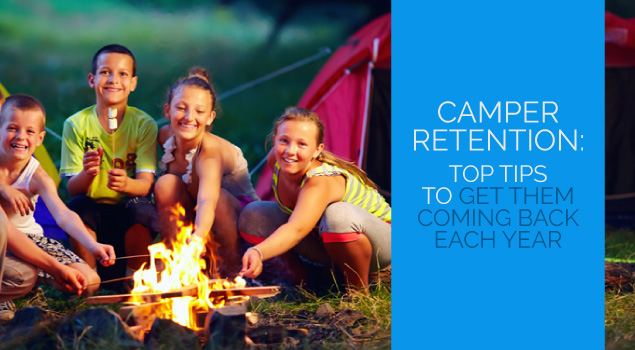 Guest post by Asaf Darash from Regpack.
Guest post by Asaf Darash from Regpack.
We’re pleased to introduce Asaf Darash as our guest blogger today. Asaf is the Founder and CEO of Regpack, with extensive experience as an entrepreneur and investor. Asaf has built three successful companies to date, all with an exit plan or that have stayed in profitability and are still functional. Asaf specializes in product development for the web, team building, and bringing a company from concept to an actualized unit that is profitable.
While kids count down the days until summer vacation, excited for what the break holds for them, their parents are grateful for the various summer programs and camps that keep their children safely engaged.
There are now camp programs and experiences offered everywhere, whether it’s posted online or just advertised in your local community. As a camp management professional, you come upon the same problem each year— how to get attendees coming back to your camp.
It’s commonly known that retaining your campers is more cost-effective than attracting new ones. To keep campers coming back, you need to both optimize your programming to provide the best experiences and develop a smart strategy to motivate registrants in the months prior.
That’s why your marketing strategy is so crucial. Whether you reach your campers best through email or social media, a solid foundation of software and tools is recommended to carry out your efforts.
From sending the first email to hosting your online registration, learn how you can leverage your management tools to increase camper retention. The better your program’s reputation, the more likely new people will register as well. In this guide, you’ll learn how to keep campers coming back with these top tips:
- Keep up email communication in the off-season
- Utilize social media for further outreach
- Incentivize registration with discounts
- Provide programming that campers want
The success of your camp program depends on how well you can meet your campers’ needs with the tools you have. Follow along with our tips to ensure you reach your campers successfully and provide a meaningful experience overall. Let’s get started!

1. Keep up email communication in the off-season.
Based on the tips in this article, one of the best ways to encourage retention is with active and consistent engagement. This means communication during the off-season.
As soon as your campers check-out and get picked up by their families, send a wrap-up email including highlights from the summer and a way for campers and parents to provide feedback. Even include an online album of photos from the program! This not only continues your positive engagement but also reminds campers of the fun time they had and showcases that to parents.
However, the engagement shouldn’t stop there. Whether you’re letting your audience know about new upcoming programs or want to get them excited to return to an existing one, there should be a marketing plan in place for the off-season.
Take a look at your camp management software and communication tool’s capabilities. It’s important that you can effectively reach your constituents, especially if you want them to remember your camp when next summer comes along. Use your tools to:
- Send emails to past campers. Easily filter your email audience so it only includes those who have been in your camp in the past. This is great if you’re advertising a new upcoming program or want to motivate past campers with various incentives.
- Save time with easy bulk messaging. Refer to email templates to get you started, and then customize them to your specific message. This way, you can quickly and easily send out one message to reach your entire camp base.
- Schedule emails in advance. Whether you have reminders that need to go out on a certain date or you like to draft messages in advance, conveniently schedule your emails for a future date and ease your mind.
- Find prospects. With your communication tool, track the responses to your marketing outreach and gain a sense of who is most excited about your program. If a parent has asked a lot of questions, they’re likely to register.
Just because your camp is over doesn’t mean you start ignoring your campers. This is a great time to keep them informed and excited about upcoming programs.

2. Utilize social media for further outreach.
Another way to increase engagement during the off-season is with social media! Social media is a great platform for two reasons:
- Your campers are already there. Youth and teens have grown up with social media, whether it’s TikTok, Facebook, or Instagram. Engage with them on a platform they’re already very familiar with.
- Most popular platforms are free to use. It’s pretty easy to create a social media profile, so there’s no harm in just making the account. Even if you don’t have content ready to post, it’s a good idea to claim your camp’s name as a username!
This is not an unfamiliar tactic. Many organizations and companies turn to social media to engage their younger consumers. From fast-food restaurants having “Twitter battles” to brands partnering with popular social media influencers, social media is a top way to engage your audience and get them dedicated to your brand. It gives your organization a personality.
If you don’t already have existing social media platforms, a good idea is to prioritize a few core networks. Don’t spread yourself too thin with 10 accounts! With only a couple of platforms to focus on, you can consistently update your audience with relevant posts and other crucial announcements. Find out where most of your campers are already active and use that platform to:
- Share photos, videos, blog posts of new information and events.
- Keep in touch with past campers.
- Highlight past achievements.
- Give shout-outs or post testimonials from past campers.
- Post related articles and news to your field.
- Inspire other users to engage back with comments, reshares, likes, etc.
However, remember this profile isn’t just for social purposes, but also for business. Make sure you carefully craft your profile and bio to still inspire your audience to register for camp. Include:
- A link to your official camp website.
- Updated contact information.
- A simple and short blurb on who you are, when you started, the ages you serve, and what kind of programming you have.
Your campers and audience are already on the platforms and engaging with organizations and brands that they care about. Why shouldn’t your camp be the same? If you’re interested in learning more about this, check out Regpack’s article on camp social media marketing.

3. Offer discounts to past campers.
Besides just keeping up engagements, a great way to motivate past campers to return is with incentives, and everybody loves a good discount. This is a common tactic many companies use to increase sales and encourage their consumers. Discounts work on the principle of urgency and exclusivity, especially if the discount is only available for a certain amount of time and is given to a set number of people.
The anticipation of missing out on a discount can be enough to encourage people to sign up. For instance, consider offering:
- Early-bird discounts to past campers if they sign up during a certain time period.
- Referral discounts to past campers who indicate they’ve referred others.
- Camper loyalty discounts to campers who’ve gone to your camp for X amount of years.
Discount codes not only incentivize your campers but are a great way to thank loyal campers and track your leads. Take a look at your camp database and determine which campers have supported you the most. Segment your email audience to just those loyal campers and send them a discount code. Additionally, depending on how many times a code is used, get a better sense of which marketing tactic is most successful!
The best camp registration tool should automate the application of discounts as someone is registering. This means registrants can sign up normally, and if a code applies to them, it’ll show up in their final price!

4. Provide programming that campers actually want.
Finally, the best way to keep campers coming back each year is to offer programming and activities that genuinely interest them. Consider sending them surveys, both asking what their favorite parts of the camp were and how your camp can be improved.
Not everyone will fill out a survey, so it’s a good idea to look at your own data. With your camp management software, all your data should be centralized in one place. This includes:
- The data from your online registration, like personal details and financial details.
- The data from your marketing tool, like which emails were opened vs. which were ignored.
- The data from your programming’s schedule, like the activity list and its schedule.
- The data from your feedback from past sessions’ surveys, like which activities were the best and what can be improved.
- The data from your past sessions, like which activities had a waitlist and which didn’t fill up.
According to Accudata, it’s important that you practice good data hygiene to ensure your database is accurate— that means no duplicate profiles nor incorrect information.
From there, consider using built-in report templates or customizing your own reports to comprehensively view your entire database and better understand it. You may realize that campers heavily signed up for one activity and ignored another.
Some camp management software also lets you manipulate your database to view certain patterns or recognize similarities. With dynamic data filtering, you can stack filters to compare and contrast why certain campers preferred one activity or marketing strategy to another!
Better understand your data to create programming that campers actually want. This way, they’re more likely to sign up for your next session.
Getting campers to come back year after year can be a challenging prospect. Make sure you leverage your camp management tools to better reach your campers and keep up positive engagement efforts. Also, with a reputation for great programming and rewards to loyal campers, it’s easier to attract new campers. Follow our top tips and good luck!
Terms and Conditions
All content provided on this blog is for informational purposes only. The owner of this blog makes no representations as to the accuracy or completeness of any information on this site or found by following any link on this site. The owner will not be liable for any errors or omissions in this information nor for the availability of this information. The owner will not be liable for any losses, injuries, or damages from the display or use of this information. This policy is subject to change at any time.

